Baghdad’s Post-Blast Wall Bibliothèque
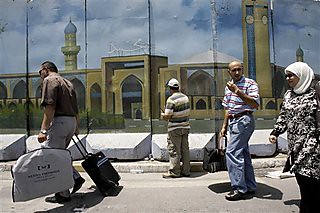
As I kept flipping through the images in this gallery of Baghdad’s incredible blast wall murals, recalling fairly recent news of how the U.S. military had begun dismantling some of the barricades in Dora (a district in Baghdad), and even more recently how control of the Green Zone was just handed over to the Iraqi government, despite all the questions of sovereignty, I wondered where those removed sections of concrete blast wall might go next; or where – theoretically, in a more hopeful future – thousands of others just like them would eventually end up as well permanently undeployed, perhaps even repurposed some how for greater urban benefit.
Which begs the question: can blast walls be reused towards something progressively humanitarian? Has this ever been architecturally explored – sort of like the work of Conclus? Can blast walls serve new housing types, micro-infrastructure, something to help actually rebuild the battered Iraqi landscape?

If the essence of military architecture has always been to guard, could these rudimentary fortifications be converted into something entirely antithetical to that – what is the opposite of defensible space exactly anyway? In this case, how could reusing the Bremmer Walls, which have consumed Baghdad, help not only to de-colonize but rebuild the city? They are each mini-colossuses, difficult to manage and move. But, can they be broken down into smaller more workable pieces in order to serve a new architectural configuration, and maybe the foundation for a revived sense of Iraq’s urban justice?
Or would it just be more practical to crush and recycle them, obliterate them from the Iraqi landscape altogether?

Other projects are addressing similar issues of picking up the pieces of post-military occupation landscapes, notably Decolonizing Architecture based in Palestine, which is looking at the abandoned remains of IDF military outposts and checkpoints littering the West Bank to determine whether they have a place on the future landscape of Palestine. Regine wrote a good review of their recent exhibition in Brussels. However, while Alessandro Petti and Sandi Hilal are primarily considering re-occupying these de-militarized shells less than really materially deconstructing and recycling them, I do recall Eyal Weizman in an interview for Canadian Architect once mentioning something about the potential of repackaging 40 years' worth of the Israeli occupation’s architectural garbage and using it to make a new wave-breaker outside Gaza’s port. That sounds amazing to me.
Nevertheless, it seems like there are possibilities for a design studio to consider how blast walls might be architecturally reimagined to serve a more direct humanitarian pursuit in post-occupied communities, I don’t know.

In order to paint the murals on Baghdad’s blast walls a specific council was formed to oversee about two dozen artists who had applied for permission and formal funding, since there were legitimate concerns the murals might be used as propaganda to inflame tribal violence, or as territorial pawns for warring Sunni and Shia contingencies, which would obviously defeat the purpose of using such a beautification project to help reclaim the colonial dimensions of the walls and remake them into something neutral, united, nationalistic, and mending of the wounded Iraqi political landscape. What other choice is there than to turn them into a tableau, or a collective public space diary of sorts – an urban scroll for baring witness to the occupation?


Tragic as it may be to say, the blast wall galleries are actually gorgeous. I realize that’s probably a controversial statement to the degree that such walls could ever be considered ‘gorgeous,’ but with all due respect the local artists (known as Jamaat al-Jidaar, or "the Walls Group") I think they have more than met the grim realities of the concrete barriers with triumphant spirit – if these imperial bricks could ever be reclaimed by those they lord over then I would say many of Baghdad’s inserted walls have been.

As much as I hope to see the blast walls in Baghdad brought down one day for good, there is a part of me that doesn’t want to see the transcendent murals lost in the mix, so I wonder: could the murals (or, even should they, for that matter) be preserved some way, say, bound in the architecture of a kind of postmodern Etruscan tomb, where future generations could pass through a labyrinth of extracted battle walls, and in a sense reread the texts of the US occupation as scrawled and dabbed in Iraq’s own eyes.
Clicking through the gallery got me to imagine the walls as the separate pages of an almost Zeusian-sized book cast and bound in concrete, like some epic future/ancient walk-through space, part bunker, part museum, part something else made legible only through an encounter with this display of brutal war walls.


Maybe we would call it a kind of post-occupation blast wall bibliothèque that you would meander through like an Egyptian mastaba, or something, gazing at these pictographs, scenes, and illustrations that have over the last several years authored Baghdad’s introspective account of the American occupation. It would be a long contemplative walk through an untangled knot of corridors weaving together a semi-ruined maze. We would read the blast walls almost as if they had forced a kind of architectural subconscious to the surface of the concrete upon which a resilient Iraqi memory had been reflected and taken refuge.
Whatever. I’m probably just completely romanticizing the shit out of these blast wall murals, and will be the first to confess. Yet, one thing that is curious (back to the issue of sovereignty): who actually owns the blast walls today, the U.S. military or the Iraqi government? What if the Iraqi Ministry of Culture decided they wanted to preserve the murals in their own way, at this point in time would they be within their rights to retain the decorated barriers somehow, or does the U.S. government hold the rights over Baghdad’s blast wall avant garde? There’s probably a very straight forward answer.

I presume, in the meantime, any chunks that are taken out of the streets would be loaded onto trucks and wheeled to either storage yards in or outside Baghdad, or back to Kurdistan perhaps where many are made. In fact the The New York Times a while back mentioned upon their removal “the bullet-pocked slabs (each the shape of a tombstone and the height of a double-decker bus) are stacked in large storage zones waiting to be used elsewhere or moved to a central depot.” Further:
Five miles south of Fadhil there is a blast-wall graveyard, for used barriers and ones that may never be put up. This is at Forward Operating Base Falcon, a United States military post near Dora.
Dora, as you can read about more in that same piece, had been a very active stage for violence until the Americans walled key parts off it off, limiting access and funneling flows into and out of the district through highly secured corridors, a strategy many credit for helping bring security to Baghdad, though not without incredible price for the locals themselves, as we have mentioned here before.


Nonetheless, it’s the ‘blast wall graveyard’ that snags my attention. James Aalan Bernsen who writes a milblog for Slate posted an interesting piece on an old T-wall graveyard in Iraq. Just a few months ago he wrote, “the concrete wall-building industry is one of the biggest industries in Iraq right now.” He said, the T-walls “have become such iconic symbols of life in Iraq that generals give miniature replicas out as departing gifts to their subordinates.” And it’s not just the Iraqi people who have been painting them, the U.S. military has also re-envisioned them.

Quoting him at length:
Many folks have taken to decorating them. At the Baghdad International Airport there's a row painted with the flag of each of the 50 states, and signed by soldiers from those states. Some of the drawings are crude, but most are elaborate and well-done:
It's not exactly China Lake, California and B-29s, but these desolate remnants of our military past will be a reminder, long after we're gone, of what it was like at the peak of the war.
Walking to lunch one day, an Army captain friend of mine nodded to some of the barriers we passed on the way. "What do you think will happen to these things when we're gone," she asked.
"I don't know. Maybe they can lay them on their sides and use them for road beds. Or for canals," I said, not too convincingly.
The truth is, there probably isn't any good use for them other than making walls, and hopefully Iraq will one day get to the point where walls aren't all that necessary anymore. Still, they're big, they're heavy, and there here, and they will likely still be here for generations -- if not centuries. Kind of like the Marsten Mats I kept running across in France that were left over from D-Day, T-walls will endure long after the American military is gone.
Well, there is a lot to be said there, I think – still, can anything be done with the T-walls?
Forgive the exploitative sentiment in my tangent here, but personally I’d love to go hang out there for a week with a serious wide-angled macro lens and photograph all the accumulated textures on the concrete super close up, inspecting those worthless objects as a kind of topographically ambiguous landscape of urban scarring and political wounding – the wall as a fossil for the brutality of occupation; remnants of a colossal crime scene.

So often, the only focus given to “the wall”, like the Israeli Separation Wall for instance, is on its greater impact on the Palestinian people (and for good reason), but what about the occupation’s impact on the Wall itself, what might the markings and impressions there be able to tell us and help identify about the violent, or even “mythic dimensions” of conflict, as Paul Virilio was after while combing the littoral remains of the Atlantic Wall? From random graffiti to various inscribed messages, to the many little ways in which the wall is informally used for things attached to it, like makeshift stepladders, marketplace racks, crawl spaces, advertisements, signage, a basketball hoop, etc. I’d love to capture the functional aspects of the wall on both sides this way, as a residual membrane, the debris of an unconscious mediation across borders, or something.

To observe the completely different meanings of each side, the wall as interface for culture compressed by intense political violence, border contest, humanitarian violation, geopolitical casualty, and so forth. Is there a bisected culture intrinsic to the wall (certainly there is) that we can trace geopolitically and use to discern something about the nature of conflict space production through meditation on the blast wall itself, and the behavior that naturally emerges in its shadow? Maybe more time needs to pass in order for the ruinous wisdom of the blast walls to reveal their dimensional secrets and cultural meanings to us. Is it too soon to see the writing on the wall, in a sense, of what these walls mean in a greater historical legacy of Empire and the military production of social space?
Put another way, what can an intimate inspection of the Wall help us to better understand about its impact on the lives of those people who brush up against it daily (Iraqi citizens and occupation soldiers alike), or of the psyche of those who have constructed these walls, who use it in some way, who are forced to confront it, avoid it, for whom the blast wall is a regular part of their psycho-spatial frame of reference, their physical and metaphysical bearings?
In our recent interview with Tom Hilde, speaking on the contemporary make-up of ‘torture space’ he wisely stated that the nature of it today is not merely one of historical evolution or “a contrast of social values,” but is rather a case of “instrumentality... both in terms of the goals of torture and the management of public opinion.” Better yet, Tom said, “Maybe even in the management of the souls of the torturers” themselves. Indeed, in those terms, what do the blast walls suggest not only about the management of public opinion of the occupation, but more interestingly about the management of the colonial souls who have themselves occupied Iraq?

I realize to any other person this might seem like an absolutely dreadful if not torturesome assignment – to wander around a storage yard of worthless concrete barriers and photograph them all day with genuine interest in the nuanced intricacies of their damage, sifting for information in their erosion, looking for a story or a bit of poetry in a single spike that had been pounded into it for some mysterious purpose. I would love to try and soak up the revelatory autobiographies of these slabs’ archeological wear and tear, as if the tombstones could whisper bits of testimony to me, or relay the dying memories or last wishes of a weary life who fell beside them; to the subtopian eye it would be a compelling foray into the realities of those who have and continue to interact with these walls on a daily basis, those who have scaled them, crawled through them, been thrown up against them, who have lost or saved their businesses because of them, hid behind them for their lives, been made to stare at them for years, whose mother’s hearts have been splattered all over them. I wonder if the cold concrete might even emit a disturbing energy from all the different projections they have absorbed over the years.
If the decaying textures on those concrete pages could tell stories then what would the chips and cracks and striated bodily patterns narrate to the unassuming anthropologist who would listen to the Wall’s stories with open and impressionable ears? While Baghdad’s murals certainly tell an Iraqi epic of historic proportion, the informal pictures dispersed in discursive threads of war torn decomposition no doubt reveal their own equally telling saga of occupied struggle. But, there are two totally different stories written on both sides of the wall, from completely different perspectives, and that fascinates me.
My objective would be to examine these remains as devices of military violence and gauge the inhumane consequences brought by them, to those on both sides – I would unravel the narrative of the wall as both a reflective threshold (double-sided mirror), and as something intentionally violent. If architecture (in it’s barest bones) were a weapon, it would be here laid out in a massive kit of parts ready to be re-assembled, re-aimed and retriggered again as the structural enforcer for an illegal occupation elsewhere. The graveyard would almost look like disjointed pieces of a new age battering ram, militarized walls without purpose; a surplus of fortressization.
But, you never know, that might not even be the least bit interesting.
More realistically, however, I wonder how long does a single blast wall typically rest in storage in today’s age of the “Global War on Terror”? Or how many more remain stored in the streets themselves? How long do these monumental tombstones sit idle before being redeployed to another violent stage, so they can essentially sit idle elsewhere in a different neighborhood, props in a slightly different configuration? Maybe even returning back to the very same place in Dora from where they began, depending; or outside the country altogether – in Kabul, for example.
I don’t know why this is so damned interesting to me. The idea of an entire landscape of blast walls squatting on the earth waiting for another foreign invasion is eerie (is this the nomadic fortress scattered in temporary hibernation?); to me they are curious war fossils lingering in a desperately unexamined state – what, if anything, can be learned about humanity from these battle-encrusted walls? Such an innocuous weapon, one that doesn’t do or perform anything at all when you think about it, they’re just bloated bricks of concrete merely taking up space in a strategic delineation; a simple wall designed to be routinely assembled and disassembled over and over again across the planet. Is this the architectural violence of biopolitical idleness in its crudest form?

I wish someone would produce a documentary on the lifespan of the blast wall, from the contracts and regulations that financialize them to the circulatory infrastructures that transport and station them, with profiles of the engineers who design and test them, to the military planners who survey and plot their specific locations, to the anonymous laborers and infantry grunts who take responsibility for actually rooting them into the ground.
Of course, the reality is that most of the slabs rarely move at all. They are erected, and then are simply moved to a storage yard nearby from where many have not moved ever since. But, I still would love to chip one with an RFID tag or something and monitor its movements over the course of, say, the next hundred years, or perhaps the past 50 might have been more interesting. What geographies would emerge in such time? Could the Wall serve as a prism in helping to deconstruct the logic of the war machine, the spatialization of disaster capitalism, the military planks of neoliberal nation building, of Empire’s exclusionary fixtures for controlling the flows of capital and superfluous populations? I don’t know, as usual, not entirely sure of my own inquiry yet. Forgive me.
As mundane as such a film project might sound some precedent has already been set in Simone Bitton’s film Mur about the Israeli Separation Wall. From the opening shot the viewer follows along the Wall in the West Bank for seemingly a roadside eternity, before getting a brief tour of the production plant that casts these concrete planks and a scene of the Wall’s unbelievably quick assembly and installation dangling from a winch. Bitton then interviews a couple of Palestinian laborers who supplied concrete in their need for work before having a conversation with Amos Yaron, the director general of Israel's Defense Ministry at the time, who called the “security fence” the “greatest engineering project the country has ever undertaken.” All in all it is a short but powerful spotlight on the industrial and political underpinnings that have surgically parceled the Wall into the earth’s surface.
Similarly, I would love to shed light on the American contractors who are building the US-Mexico border fence, a project that will continue to cost millions annually on down the road just in order to maintain from weather conditions and cross-border sabotage.
Today, companies are cashing in on billions by building highly fortified fences and barriers all over the world. To expose the capitalist machine behind this border-industrial-complex from the perspective of its own product just seems like a critically appealing project to me. One day.
I may be all alone on this one, but what a story it would be to follow a specific 12 by 5 foot tall concrete T-wall that begins its life in an Israeli manufacturing camp outside the West Bank, from the time it’s set to dry to being fitted into place overlooking an eighty year old Palestinian farmer struggling to keep his farm. With a solar charged panoramic camera on top to record everything, we find several months later this section of blast wall is unexpectedly removed and stored in a nearby bunker while the IDF plans to redraw the boundary more directly through this village.
Yet, in the same time, we learn there is a kind of unofficial Secretary of Walls who has somehow emerged in recent years to oversee the global administration of NATO’s inventory of war-time barriers. Say, for a moment all of the concrete barricade and blast wall hydrology that has ever controlled the flows of militant rebels, insurgents, refugees, squatter communities, migrants, had been accounted for statistically in the books of this unnamed secretary. However this inventory has come to exist, let’s just entertain the thought that hundreds of thousands of blast wall blocks over the course of decades have been regularly moved by an international network of heavy lifters, stacked upon oversized flatbeds in convoys and rolled across continents back and forth from a curious central crypt somewhere deep in Central Asia whose only purpose is to archive reams of concrete slab designed for war, where inside at some point the Great Fragmented Wall of Baghdad once filled a dozen underground warehouses neatly piled and ordered within a leviathan card catalog system indicating its pieces by their unique sizes, weights, thicknesses, blast proof calibers, all numbered sequentially like the boxcars of a 100 mile long train you find broken down in a rail yard somewhere in California. The unread pages of war’s indestructible tome just lying in wait – in weight, until the military academics of Empire decide one day to unfurl them again in the field.
There is of course a giant bureaucracy around these walls, and the Secretary does his job frighteningly well when he suddenly gives the order to the IDF to ship this one slab off to a random intersection in the banlieues of Paris. A Kurdish blast wall cartel and his underpaid haulers are called in for the job. Old pros – the best in the biz. After a ferocious month of street rioting there the wall is then immediately moved to a contentious immigrant grotto in the south of Italy, for weeks absorbing the backlash of angry mobs, riot police, hate groups and migrant rights activists together, testing the limits of its structural integrity with heavy collisions, only to find itself later that year used as the cover for a Lebanese smuggler on the border with Syria who stashes small amounts of hash within the crumbling crevices that have been excavated into it by urban conflicts that took place hundreds of miles away, until eventually during its transport from the Middle East to South Asia it slips off the winch of a Chinese forklift and shatters into 4,378 pieces inside an anonymous warehouse somewhere in the outback of Mongolia, where it, along with tiny morsels of unenjoyed hash and unread notes and wads of cash, are swept into some waste pile and it’s life of traveling obstinacy comes to an abrupt end.
Others are tracked, too, through Cairo and Kinshasa before filling security orders in Tijuana, Rio, Jakarta, and Mogadishu. Through out their journeys many of the walls are painted over by layers and layers of murals from previous occupations, conflicts, fierce activism, overall compiling a richly textured visual history of a worldwide militarism movement and its vibrant resistance who together face a violent unknown in these walls, before leaving their own indelible imprints on them, adding to a sort of run-on story that only the walls themselves go on to tell.

With each new occupation the walls bare witness to the brutalities they themselves accompany, acquiring their own knowledge, and become a sort of cultural measure of geopolitical conflict.
Certain blast wall sections would gain special notoriety for particular artwork that had gathered upon them. A bizarre new art industry would even emerge around them. Perhaps one wall, with Baghdad’s art preciously blanketing it, winds up in São Paulo, where Os Gêmeos take their spray cans to it but with total respect for the distant image that has landed in their city and add their own element, at which point art collectors worldwide begin to take notice. Suddenly the blast wall has incredible value, worth thousands on the art market, until a German trader manages to pull off the heist of the century with his cronies from an earlier mission in Berlin, and gets away with the wall inside a massive crate buried at the bottom of some cargo ship headed for Turkey, where it will be sold on the black market back to the Kurdish blast wall cartel who is now recollecting all of Baghdad’s wayward blast walls in a secret underground lair, stacking them like concrete bullion with incredible archival display meant only for the world’s blast wall connoisseurs, like Fidel Castro, Salaman Rushdie, and even Angelina Jolie who regularly peruse the archive and each have sections from the West Bank bombed by Banksy, and chunks from Sinai's barriers adorned with Twist’s famous boozers in their own personal collections.

While a strange consortium of revolutionary art purveyors, blast wall smugglers, dictators, ex-generals, guerilla leaders, and maybe even art institutions would haggle over them with other unsuspecting collectors of military artifact, the walls would become a strange kind of currency amongst military planners, who would drive the Secretary crazy scrapping over them and their own perceived property rights while lobbying to regulate the further rate of production of new blast walls. Until eventually the Pentagon realizes their cultural value and suddenly they all start disappearing, one by one, and a new an improved cheaper form of plastic blast wall begins to hit the war market in its place.
Anyway, you get the idea. Who knows, the real story would more than likely turn out an incredibly boring-ass examination of a bunch of barbaric hard hats with absolutely no personality whatsoever, or anything remotely interesting to say beyond the daily barks of any old construction firm that contracts for the military. No offense! But, is there a more curious economy there, a more intriguing political story, a strange subculture, an informal market place for the blast wall? I would love to explore this earlier post -- In the Business of Blast Walls -- a little further some day.
I’m certainly no historian of military space, but in this post-Euclidian age of hyperterritorial friction, overlapping infoscapes, autonomous systems, virtual infrastructures and network sovereignty, asymmetric warfare and so forth, the blast wall is a creepy physical reciprocation of the same micro-bordering that is so characteristic of global space production today. It’s a gratuitous structure, utterly anti-technological. The blast wall is the wall of a super-imposed sovereignty; a retro-medieval intra-urban insertion fulfilling the military urge to reoccupy and redraw the geometries of the city into angular funnels of power, redirecting traffic and forcing new trajectories for the ways battles are staged in cities. Blast walls are prosthetic scaffolding tilting the floors of power in favor of occupation.
Paul Virilio in his classic meditation Bunker Archeology would call this the “strategic geometrizing” of “defensive redoubt” that gives the military the ability to convert the city into a fragmented prison overnight by suddenly dropping a bunch of walls into it that throw entire districts into lockdown. The war of the future, as we already know, is one not between city but within it. What will this mean for the spatial logic of the rule of law as time goes on? What will the future military dimensions of space control in the city look like next? How will the blast wall continue to evolve?

Not just fortified enclosures anymore, but entire cities of walls riddled with checkpoints from the inside out. The sabotaged lattice space of spontaneous violence, blocks of carceral control, a rash of blast walls reprogramming the city’s spatial logic. The wall evolving into something completely mobile, like two-ton books of concrete slab that slide out on great cantilevers, choking the isle ways of the city, creating new ones on the Borgesian shelves of Baghdad’s mythological Bibliothèque. Walls that freely move – Matrix 'desert of the real' style. As if the wall has reached military projectile status itself now; a weapon – bombing a landscape with viral walls that can attach and detach at any point, inject, leach, siphon, stack, infect and divert flows. An autonomous mazing, or military labyrinthizing of the metropolis. Ironically, then, whereas cities were once about the establishment of vehicular infrastructure to help speed up the culture of production, the blast wall is response to a culture of car bombs aimed at defeating the predation of a global system that’s hijacked the city. Baghdad has long been an open sky library for volumes of political violence and architectural memory.
Virilio also talks about the issue of time and (as does Ballard) the morphology of modern fortifications that developed in unison with the shortening of military conflicts, wars that can be waged overnight and won in the course of a few days, and how military space has enabled this. Aren’t the contemporary blast walls the perfect incarnation of the “GWOT”’s indefinite time-space dimensions, since they’ve been designed to be extraordinarily temporary, but have persisted in the battlefield now to the point of near permanence? These deposits are the urban translation of a suspension of government, a war on law – Baghdad’s state of emergency; the pages of a city made in concretized walls of exception.
Philip Misselwitz refers to this as “conflict urbanism”, or as he and Tim Rieniets describe it: “a city that changes its physical form, infrastructural systems and in an accelerated, at times almost daily fashion. Processes of urban change such as road planning, closures, construction of walls, fences, etc. that require year-long planning processes in Western cities can be implemented virtually over night – an uneasy, panicked ridden dynamism, that relies on the rapid implementation of facts on the ground. This permanent state of radical transformation has involved a dramatic, physical and demographic growth, as well as unprecedented decline and destruction."
Anyway, in ways similar to how the global financial system is not only a blueprint for an economy of trade but an economy of space production, you could say architecture in this case is the logic used to organize an economy of walls that configures space for habitability, capital production, mobility, spatial control and war; architecture, while a product of the economy itself is also just a means for commodifying walls. More specifically, the economy of war is an economy of walls, like the prison industrial-complex is an economy of walls.
If Dubai’s towers represent neoliberal stockpiles of currency in spatial form on one side of the spectrum, then the endless paging of blast walls might represent the equivalent architectural cache of neoliberalism's militaristic expansion on the other side that’s been needed to secure its vertical gated communities that stretch half a mile high. Is that what the translation of this global economic collapse will continue to boil down to: surging Burj Dubais and teething Bremmer Walls?
Whatever, I’m talking out of my ass, as usual, but – the blast wall tells us something, and I guess I’m on some silly mission to try and find out what it is, as far off as I still may be. Though, again, maybe its meaning will come later, in some future use, reformed, de-colonized, rehumanized. Out.
Galleries: LAT, WSJ, NYT, Guardian.







4 Comments:
The shorter ones might work as terracing to prevent erosion on steep hillsides. Would they need holes for drainage? Could the tall ones be shortened? Are there any hills near enough for this to be economical?
I think they could be used as walls for utility shelters. Then you'd only need a roof. They can definitly be used as walls for military bases if the Iraq army expands. cut them down for use as highway barriers and the remaining slabs can be used as huge cinder blocks or really heavy duty side walks.
excellent article. dont forget parallels to Berlin Wall sections that have evolved into avant guarde art as backdrops for fashion shows, photo shoots, etc. slowly numbing the pain and historical significance they hold.
Nice post, Bryan. There's something oddly poetic about these incredibly banal things. They beg for an artistic response -- Sol LeWitt meets Eleanor Antin, perhaps. Yet another voice tells me to pile these pieces of war waste in a non-burnable pyre in some deserted locale and leave them in an incredible huddle to be found Ozymandius-like several centuries hence. And, yes, there's always good old adaptive reuse, which itself is a kind of art.
Post a Comment
<< Home